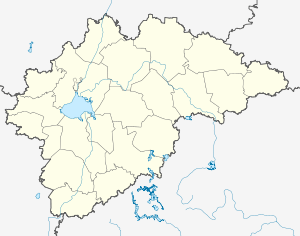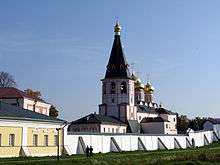Valday, Novgorod Oblast
| Valday (English) Валдай (Russian) | |
|---|---|
| - Town[1] - | |
 Komsomolsky Avenue in Valday | |
.svg.png) Location of Novgorod Oblast in Russia | |
 Valday | |
|
| |
.png) |
|
|
| |
| Administrative status (as of April 2014) | |
| Country | Russia |
| Federal subject | Novgorod Oblast[1] |
| Administrative district | Valdaysky District[1] |
| Town of district significance | Valday[2] |
| Administrative center of | Valdaysky District,[1] town of district significance of Valday[2] |
| Municipal status (as of March 2013) | |
| Municipal district | Valdaysky Municipal District[3] |
| Urban settlement | Valdayskoye Urban Settlement[4] |
| Administrative center of | Valdaysky Municipal District,[3] Valdayskoye Urban Settlement[4] |
| Statistics | |
| Population (2010 Census) | 16,098 inhabitants[5] |
| Time zone | MSK (UTC+03:00)[6] |
| First mentioned | 1495[7] |
| Town status since | 1770[8] |
| Postal code(s)[9] | 175400, 175402–175405, 175449 |
|
| |
| Valday on Wikimedia Commons | |
Valday[10] (Russian: Валда́й) is a town and the administrative center of Valdaysky District in Novgorod Oblast, Russia, located on the southwestern shore of Lake Valdayskoye, the biggest one in the set of lakes in the highest region of the Valdai Hills, on the M10 Highway connecting Moscow and St. Petersburg, 386 kilometers (240 mi) from Moscow and 140 kilometers (87 mi) from Veliky Novgorod, the administrative center of the oblast. Population: 16,098 (2010 Census);[5] 18,703 (2002 Census);[11] 19,173 (1989 Census).[12]
History
It was first mentioned in a chronicle in 1495.[7] At the time, it was a part of Derevskaya Pyatina of the Novgorod Republic.[7] The growth of Valday was facilitated by construction of a road connecting Novgorod to Central Russia and by the foundation of the Valday Iversky Monastery in 1653, which became a major cultural center. The famous monastery, built under the auspices of Patriarch Nikon in the 1650s, is located on one of the islands of Lake Valdayskoye.

In the course of the administrative reform carried out in 1708 by Peter the Great, the territory was included into Ingermanland Governorate (known since 1710 as St. Petersburg Governorate). In 1727, separate Novgorod Governorate was split off. In 1770, Valday was chartered[8] and became the seat of Valdaysky Uyezd of Novgorod Viceroyalty. In 1796, the viceroyalty was transformed into Novgorod Governorate.[13] Located along the road connecting Moscow and St. Petersburg, Valday developed as a major trade center. The town became the leading center of bell manufacturing in Russia. It also became a major pilgrim destination.
In August 1927, the uyezds were abolished and, effective October 1, 1927, Valdaysky District was established, with the administrative center in Valday.[14] Novgorod Governorate was abolished as well and the district became a part of Borovichi Okrug of Leningrad Oblast.[14] On July 23, 1930, the okrugs were abolished and the districts were directly subordinated to the oblast.[14] Valday was close to the eastern front line for Russia during World War II, but was never occupied by German troops. On July 5, 1944, Valdaysky District was transferred to newly established Novgorod Oblast and remained there ever since.[15]
Administrative and municipal status
Within the framework of administrative divisions, Valday serves as the administrative center of Valdaysky District.[1] As an administrative division, it is, together with the selo of Zimogorye, incorporated within Valdaysky District as the town of district significance of Valday.[2] As a municipal division, the town of district significance of Valday is incorporated within Valdaysky Municipal District as Valdayskoye Urban Settlement.[4]
Economy
Industry
In Valday, there are enterprises of timber and food industries, as well as enterprises producing optical devices and pumps.[16]
Transportation
A railway which connects Bologoye and Pskov via Staraya Russa passes through Valday. The town also has a railway connection with Kresttsy. There is no passenger traffic but the railway is in use for cargo traffic.
Valday is located on the M10 Highway which connects Moscow and St. Petersburg. There is a road connection to Okulovka, as well as local roads.
Culture and tourism
Valday is a popular tourist destination, situated in the middle of the Valdaysky National Park. Most tourists visit the lake and the town during the summer. Valday features many recreation facilities and sanatoria, with many camping places available around the lake. The first meeting of the Valdai International Discussion Club was also held on the lake.
Valday contains forty-three cultural heritage monuments of federal significance and additionally seventy-four objects classified as cultural and historical heritage of local significance.[17] The federal monuments are the ensemble of Valday Iversky Monastery, the Presentation Church, and a park.
The Valdaysky District Museum, located in Valday, displays two exhibitions. One is devoted to the history of Valday as an uyezd seat in the 19th century. This part of the museum is located in the Mikhaylova House, a 19th-century historical building. The second part, in the former Church of St. Catherine, highlights the history of Valday bell-making.[18] In the end of the 18th and in the 19th century, bell-making was a traditional handicraft in Valday. Big church bells, as well as small bells which were hung to a horse harness, were produced.[7]
_02.jpg)
Residence of the President of Russia
Very close to the town on the coast of Lake Valdayskoye there is a residence of the President of Russia. The complex of buildings is highly secured and a large sector of the lake is closed for boats and swimmers. This place was frequented by President Boris Yeltsin and is also Vladimir Putin's favorite.
Sister Cities
References
Notes
- 1 2 3 4 5 Law #559-OZ
- 1 2 3 Resolution #121
- 1 2 Law #284-OZ
- 1 2 3 Law #371-OZ
- 1 2 Russian Federal State Statistics Service (2011). "Всероссийская перепись населения 2010 года. Том 1" [2010 All-Russian Population Census, vol. 1]. Всероссийская перепись населения 2010 года (2010 All-Russia Population Census) (in Russian). Federal State Statistics Service. Retrieved June 29, 2012.
- ↑ Правительство Российской Федерации. Федеральный закон №107-ФЗ от 3 июня 2011 г. «Об исчислении времени», в ред. Федерального закона №271-ФЗ от 03 июля 2016 г. «О внесении изменений в Федеральный закон "Об исчислении времени"». Вступил в силу по истечении шестидесяти дней после дня официального опубликования (6 августа 2011 г.). Опубликован: "Российская газета", №120, 6 июня 2011 г. (Government of the Russian Federation. Federal Law #107-FZ of June 31, 2011 On Calculating Time, as amended by the Federal Law #271-FZ of July 03, 2016 On Amending Federal Law "On Calculating Time". Effective as of after sixty days following the day of the official publication.).
- 1 2 3 4 История города и района (in Russian). Официальный сайт Администрации Валдайского муниципального района. 2012. Retrieved May 28, 2014.
- 1 2 Энциклопедия Города России. Moscow: Большая Российская Энциклопедия. 2003. p. 62. ISBN 5-7107-7399-9.
- ↑ Почта России. Информационно-вычислительный центр ОАСУ РПО. (Russian Post). Поиск объектов почтовой связи (Postal Objects Search) (Russian)
- ↑ The name is alternatively spelled Valdai
- ↑ Russian Federal State Statistics Service (May 21, 2004). "Численность населения России, субъектов Российской Федерации в составе федеральных округов, районов, городских поселений, сельских населённых пунктов – районных центров и сельских населённых пунктов с населением 3 тысячи и более человек" [Population of Russia, Its Federal Districts, Federal Subjects, Districts, Urban Localities, Rural Localities—Administrative Centers, and Rural Localities with Population of Over 3,000] (XLS). Всероссийская перепись населения 2002 года [All-Russia Population Census of 2002] (in Russian). Retrieved August 9, 2014.
- ↑ Demoscope Weekly (1989). "Всесоюзная перепись населения 1989 г. Численность наличного населения союзных и автономных республик, автономных областей и округов, краёв, областей, районов, городских поселений и сёл-райцентров" [All Union Population Census of 1989: Present Population of Union and Autonomous Republics, Autonomous Oblasts and Okrugs, Krais, Oblasts, Districts, Urban Settlements, and Villages Serving as District Administrative Centers]. Всесоюзная перепись населения 1989 года [All-Union Population Census of 1989] (in Russian). Институт демографии Национального исследовательского университета: Высшая школа экономики [Institute of Demography at the National Research University: Higher School of Economics]. Retrieved August 9, 2014.
- ↑ Snytko et al., p. 22
- 1 2 3 Snytko et al., p. 85
- ↑ Snytko et al., p. 100
- ↑ Район сегодня (in Russian). Администрация Валдайского муниципального района. Retrieved February 8, 2012.
- ↑ Памятники истории и культуры народов Российской Федерации (in Russian). Russian Ministry of Culture. Retrieved 2 June 2016.
- ↑ Валдайский краеведческий музей (in Russian). Российская сеть культурного наследия. Retrieved February 8, 2012.
Sources
- Снытко, О. В. (2009). С. Д. Трифонов; Т. Б. Чуйкова; Л. В. Федина; А. Э. Дубоносова, eds. Административно-территориальное деление Новгородской губернии и области 1727-1995 гг. Справочник (PDF) (in Russian). St. Petersburg. Retrieved May 28, 2014.
- Новгородская областная Дума. Областной закон №559-ОЗ от 11 ноября 2005 г. «Об административно-территориальном устройстве Новгородской области», в ред. Областного закона №730-ОЗ от 26 февраля 2015 г. «О внесении изменений в Областной закон "Об административно-территориальном устройстве Новгородской области"». Вступил в силу 1 января 2006 г. Опубликован: "Новгородские ведомости", №75, 23 ноября 2005 г. (Novgorod Oblast Duma. Oblast Law #559-OZ of November 11, 2005 On the Administrative-Territorial Structure of Novgorod Oblast, as amended by the Oblast Law #730-OZ of February 26, 2015 On Amending the Oblast Law "On the Administrative-Territorial Structure of Novgorod Oblast". Effective as of January 1, 2006.).
- Администрация Новгородской области. Постановление №121 от 8 апреля 2008 г. «Об реестре административно-территориального устройства области», в ред. Постановления №408 от 4 августа 2014 г. «О внесении изменений в реестр административно-территориального устройства области». Опубликован: "Новгородские ведомости", №49–50, 16 апреля 2008 г. (Administration of Novgorod Oblast. Resolution #121 of April 8, 2008 On the Registry of the Administrative-Territorial Structure of Novgorod Oblast, as amended by the Resolution #408 of August 4, 2014 On Amending the Registry of the Administrative-Territorial Structure of Novgorod Oblast. ).
- Новгородская областная Дума. Областной закон №284-ОЗ от 7 июня 2004 г. «О наделении сельских районов и города Великий Новгород статусом муниципальных районов и городского округа Новгородской области и утверждении границ их территорий», в ред. Областного закона №802-ОЗ от 31 августа 2015 г. «О внесении изменений в некоторые областные Законы, устанавливающие границы муниципальных образований». Вступил в силу со дня, следующего за днём официального опубликования. Опубликован: "Новгородские ведомости", №86, 22 июня 2004 г. (Novgorod Oblast Duma. Oblast Law #284-OZ of June 7, 2004 On Granting the Status of Municipal Districts and Urban Okrug of Novgorod Oblast to the Rural Districts and the City of Veliky Novgorod and on Establishing the Borders of Their Territories, as amended by the Oblast Law #802-OZ of August 31, 2015 On Amending Various Oblast Laws Establishing the Borders of the Municipal Formations. Effective as of the day following the day of the official publication.).
- Новгородская областная Дума. Областной закон №371-ОЗ от 22 декабря 2004 г. «Об установлении границ муниципальных образований, входящих в состав территории Валдайского муниципального района, наделении их статусом городского и сельских поселений, определении административных центров и перечня населённых пунктов, входящих в состав территорий поселений», в ред. Областного закона №216-ОЗ от 1 марта 2013 г. «О внесении изменений в некоторые областные законы, содержащие перечни населённых пунктов, входящих в состав территорий поселений». Вступил в силу со дня, следующего за днём официального опубликования. Опубликован: "Новгородские ведомости", №2, 12 января 2005 г. (Novgorod Oblast Duma. Oblast Law #371-OZ of December 22, 2004 On Establishing the Borders of the Municipal Formations Within the Territory of Valdaysky Municipal District, on Granting Them the Status of Urban and Rural Settlements, on Establishing Their Administrative Centers, and on Compiling the Lists of Inhabited Localities Within the Settlement Territories, as amended by the Oblast Law #216-OZ of March 1, 2013 On Amending Various Oblast Laws Containing the Lists of Inhabited Localities Within the Settlement Territories. Effective as of the day following the day of the official publication.).
External links
- Official website of Valday (Russian)
- Unofficial website of Valday (Russian)